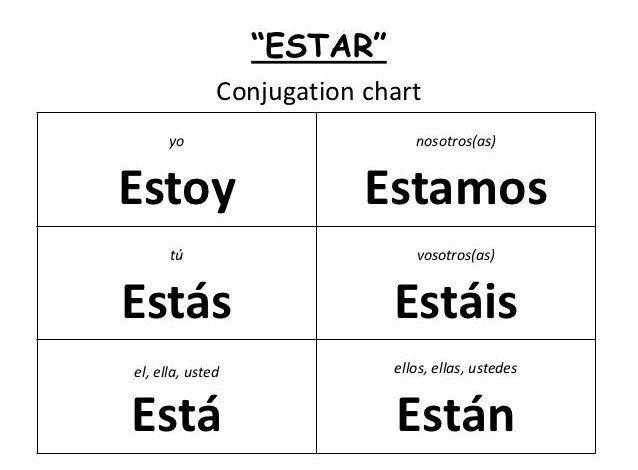Estar Imperfect Conjugation: A Complete Guide to Spanish Verb Tenses

The Spanish language, with its rich grammatical structure, can be challenging for learners, especially when it comes to conjugating verbs in various tenses. Among the most important verbs to master is estar, which is used to express temporary states, conditions, and locations. One of the critical tenses in Spanish is the imperfect tense, and understanding the estar imperfect conjugation is essential for anyone looking to speak and write fluently in the language. In this guide, we will explore how to conjugate estar in the imperfect tense, its usage, and how it compares to other tenses like the preterite.
To fully grasp the estar imperfect conjugation, you must first understand the role of the verb estar in the Spanish language. Estar means “to be,” and it is used to describe temporary conditions, emotions, or locations. For instance, you would say, yo estoy cansado (“I am tired”) to describe a temporary state. On the other hand, ser is the verb used for permanent characteristics, such as identity or nationality. The estar imperfect conjugation plays a critical role in past tense descriptions, as it helps convey ongoing or habitual actions that were happening over a period of time.
The Basics of Estar Imperfect Conjugation
In the estar imperfect conjugation, the verb is used to describe actions or states that were ongoing or habitual in the past. Unlike the preterite tense, which describes actions that were completed, the imperfect tense emphasizes continuity and repetition. The conjugation of estar in the imperfect tense follows a regular pattern for -ar verbs in Spanish, making it easier for learners to grasp. The key conjugation forms are:
- Yo estaba (I was)
- Tú estabas (You were)
- Él/ella/Ud. estaba (He/she/You were)
- Nosotros estábamos (We were)
- Vosotros estabais (You all were)
- Ellos/ellas/Uds. estaban (They/You all were)
Each form of the estar imperfect conjugation corresponds to a subject pronoun, allowing you to easily match the conjugation to the subject of your sentence. For example, when you say estaba feliz (“I was happy”), you’re using the first-person singular form to describe a temporary emotional state in the past.
How Estar Imperfect Tense is Used in Context
The estar imperfect conjugation is essential for describing actions that were ongoing, habitual, or repeated over time. For instance, if you were to describe an ongoing action in the past, such as yo estaba estudiando (“I was studying”), it highlights that the action was happening over a span of time, without indicating its completion. The imperfect tense of estar can also be used to describe past conditions, locations, or emotions that were happening continuously. An example could be estaba en casa todo el día (“I was at home all day”), indicating that the action of being at home took place over a period of time.
Moreover, the estar imperfect conjugation is frequently used to describe habitual past actions. For instance, if you want to talk about something you used to do regularly in the past, you can say cuando era niño, siempre estaba jugando fútbol (“When I was a child, I was always playing soccer”). This helps give your sentences a sense of duration, continuity, and context.
Comparing Estar vs Ser in the Imperfect Tense

One of the most significant challenges when learning Spanish is understanding when to use estar versus ser. Both verbs mean “to be,” but they are used in different contexts. The verb ser is used to express permanent traits, such as identity, origin, and profession. In contrast, estar is used to describe temporary states, locations, and conditions. When conjugating both verbs in the imperfect tense, it is important to know which verb to choose based on the nature of the situation you are describing.
For example, you would say yo era médico (“I was a doctor”) to describe a permanent occupation in the past, but you would say yo estaba cansado (“I was tired”) to describe a temporary state of being. Both verbs are essential in Spanish, but they serve different functions depending on whether you’re talking about something that is permanent or temporary. Mastering the estar imperfect conjugation in contrast to the conjugation of ser will help you speak Spanish more naturally and accurately.
Practical Examples of Estar Imperfect Conjugation
Let’s delve deeper into real-life examples to understand the estar imperfect conjugation in action. The imperfect tense is often used to talk about things that used to happen regularly or were ongoing in the past. For instance, if you were to say cuando vivía en México, estaba aprendiendo español (“When I lived in Mexico, I was learning Spanish”), you’re describing an action that was ongoing in the past, without specifying when it was completed.
Another example of the estar imperfect conjugation can be seen in the sentence estábamos en la fiesta cuando empezó a llover (“We were at the party when it started raining”). Here, the imperfect tense is used to describe the ongoing state of being at the party while something else (the rain) interrupted the action. This is a useful construction when describing events in the past that were happening simultaneously.
Mastering Estar Conjugation Charts and Key Forms for All Tenses
To fully understand the estar imperfect conjugation and how it fits within the broader picture of Spanish verb conjugation, it’s essential to familiarize yourself with the various forms of estar across different tenses. A well-rounded understanding of the conjugation of estar in the present, past (imperfect and preterite), future, and subjunctive tenses will make you a more fluent and accurate Spanish speaker.
Here’s a quick summary of estar in different tenses:
- Present tense: estoy (I am), estás (you are), está (he/she/you are)
- Imperfect tense: estaba (I was), estabas (you were), estaba (he/she/you were)
- Preterite tense: estuve (I was), estuviste (you were), estuvo (he/she/you were)
- Future tense: estaré (I will be), estarás (you will be), estará (he/she/you will be)
Understanding the full range of estar conjugations, including the estar imperfect conjugation, provides you with the flexibility to talk about the present, past, and future with ease. Regular practice with these conjugations will help you speak fluently and confidently, whether you are describing past conditions or making predictions about the future.
Conclusion
The estar imperfect conjugation is a vital component of the Spanish language, allowing speakers to describe past actions, conditions, and habitual behaviors. By understanding the conjugation forms and when to use them, learners can communicate more effectively in the past tense, describing ongoing states and repeated actions with clarity. Whether you’re practicing with a conjugation chart or using examples in real-life scenarios, mastering the imperfect tense of estar will significantly enhance your Spanish proficiency.
FAQs
- What is the difference between the imperfect and preterite tenses in Spanish? The imperfect tense is used for ongoing or habitual actions in the past, while the preterite tense is used for actions that were completed.
- How do I know when to use “estar” instead of “ser”? Use estar for temporary states, emotions, or locations, and ser for permanent qualities or characteristics.
- Can “estar” be used to describe permanent states? No, estar is reserved for temporary states, while ser is used for permanent attributes.
- What are some common mistakes to avoid when using the imperfect conjugation of “estar”? A common mistake is confusing the imperfect with the preterite, which changes the meaning of the sentence.
- How do I conjugate “estar” in other tenses, like the subjunctive or future tense? Estar is conjugated regularly in other tenses, following specific patterns that depend on the tense and subject pronoun.
- What are some examples of using “estar” in the past tense to describe emotions or conditions? “Estaba feliz” (I was happy), “Estaba enfermo” (I was sick) are examples of emotions and conditions in the imperfect tense.
- Can “estar” be used in both the singular and plural forms for subjects? Yes, estar is conjugated differently depending on the singular or plural subject.
- Why is the imperfect tense important in Spanish grammar? The imperfect tense is crucial for describing ongoing actions or habitual past behaviors, helping to provide a complete picture of past events.
- How do I practice conjugating “estar” effectively? Regular practice with conjugation charts, flashcards, and language exercises can help improve your understanding and fluency.
- Is “estar” used in the same way across all Spanish-speaking countries? Yes, although some regional variations may exist, the conjugation and general usage of estar are consistent across Spanish-speaking countries.
You may also read: Crackwatch: The Ultimate Resource for Cracked Games





